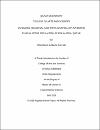Dynamics (Seasonal and Intra-diurnal) of air-borne fungal spore population of Doha Area, Qatar
| Advisor | Abu-Dieyeh, Mohammed |
| Author | Fayad, Raghdaa Kamal |
| Available date | 2016-12-11T08:42:04Z |
| Publication Date | 2016 |
| Abstract | Airborne fungi are considered to cause adverse health impacts on humans, animals and plants. Fungal spores and due to their volume in the atmosphere and small size have an important contribution to the respiratory dysfunctions, allergies and to cause various symptoms range from asthma, allergic rhinitis to bronchitis. The availability and dynamics of airborne fungal spores in the atmosphere are strongly influenced by the meteorological parameters and by other factors such as air pollutants. From 106 settle plate exposures (on alternative days) throughout the period April 2015-March 2016, a total of 1197 mould- and 283 yeast colony-forming units (CFU), twenty one genera and 62 species were retrieved. The highest fungal spore’s concentration was recorded in February 2016, whereas the lowest concentration occurred in August 2015. The main constituents of the fungal airspora were attributed to Cladosporium (60.2 %), Aspergillus (10.4 %), Fusarium (9.4%), Alternaria (8.5 %), and Ganoderma spp. (2.3 %). Cladosporium showed two peaks in April and February, while Fusarium and Alteranria peaked in July. Aspirgillus had one peak in August. The prevalence of Ganoderma spp. were exclusively detected in February and March. Temperature was significantly and negatively correlated with the total colony count and fungal species, however no significant correlation was found between relative humidity and both the total colony count and fungal species. Wind speed was significantly and positively correlated with the total colony count and fungal species. However, no significant correlation was detected between wind direction and the incidence of fungal airspora. The correlation between rainfall and either total colony count or fungal species was non-significant. However, Alternaria was significantly and positively correlated with precipitation. Intra-diurnal fluctuations of fungal spores was investigated during the period of 1st of Feb - 31st of March 2016. The highest dispersal of fungal spores favored 18:00 h, whereas at 00:00 h (midnight) the lowest fungal spores release was recorded. The mean daily colony count was negatively correlated with mean daily relative humidity and positively correlated with mean daily temperature. The potentiality of fungal growth on different media on two different culture media, Potato Dextrose Agar (PDA) and Rose Bengal were examined during 1st of Feb - 31st of March 2016 using gravimetric method. No significant difference was observed in total number of fungal colonies or species collected with the two media. Nevertheless, certain fungal taxa were highly selective and thus their growth rate was on one media much higher than with another. The impact of atmospheric CO2 concentration on the abundance and diversity of airborne fungal spores were investigated at two different locations. There were no significant differences in the composition and diversity of the airborne fungal population between the two study sites, though daily concentration of CO2 was higher at the Industrial area site than at Qatar University Campus. Remarkably, the concentrations of Alternaria spp. and Fusarium spp. were significantly higher at Industrial area site in Corresponding to CO2 than at Qatar University site |
| Language | en |
| Subject | Aeromycology Airborne fungi Doha Meteorological parameters Qatar Seasonal variations Environmental science |
| Type | Master Thesis |
| Department | Environmental Sciences |
Files in this item
This item appears in the following Collection(s)
-
Biological & Environmental Sciences [111 items ]


